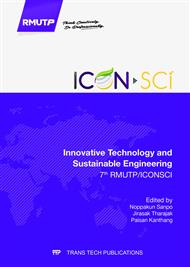[1]
M. Mohapatra, S. Anand, B.K. Mishra, Dion E. Giles, P. Singh, Review of fluoride removal from drinking water, J. Environ. Manage. 91 (2009) 67-77.
DOI: 10.1016/j.jenvman.2009.08.015
Google Scholar
[2]
S. Jagtap, M.K. Yenkie, N. Labhsetwar, S. Rayalu, Fluoride in drinking water and defluoridation of water, Chem. Rev. 112 (2012) 2454-2466.
DOI: 10.1021/cr2002855
Google Scholar
[3]
P. Loganathan, S. Vigneswaran, J. Kandasamy, R. Naidu, Defluoridation of drinking water using adsorption processes, J. Hazard. Mater. 248-249 (2013) 1-19.
DOI: 10.1016/j.jhazmat.2012.12.043
Google Scholar
[4]
S.S. Tripathy, J.L. Bersillon, K. Gopal, Removal of fluoride from drinking water by adsorption onto alum-impregnated activated alumina. Sep. Purif. Technol. 50 (2006) 310-317.
DOI: 10.1016/j.seppur.2005.11.036
Google Scholar
[5]
C. Zevenbergen, L.P. van Reeuwijk, G. Frapporti, R.J. Louws, R.D. Schuiling, A simple method for defluoridation of drinking water at village level by adsorption on Ando soil in Kenya, Sci. Total Environ. 188 (1996) 225-232.
DOI: 10.1016/0048-9697(96)05174-1
Google Scholar
[6]
S. Chidambaram, S. Manikandan, A.L. Ramanathan, M.V. Prasanna, C. Thivya, U. Karmegam, R. Thilagavathi, K. Rajkumar, A study on the defluoridation in water by using natural soil, Appl. Water Sci. 3 (2013) 741-751.
DOI: 10.1007/s13201-013-0122-1
Google Scholar
[7]
M. Agarwal, K. Rai, R. Shrivastav, S. Dass, Deflouridation of water using amended clay, J, Clean Prod. 11 (2003) 439-444.
DOI: 10.1016/s0959-6526(02)00065-3
Google Scholar
[8]
A.K. Yadav, C.P. Kaushik, A.K. Haritash, A. Kansal, N. Rani, Defluoridation of groundwater using brick powder as an adsorbentJ. Hazard. Mater. B128 (2006) 289-293.
DOI: 10.1016/j.jhazmat.2005.08.006
Google Scholar
[9]
S.P. Kamble, P. Dixit, S.S. Rayalu, N.K. Labhsetwar, Defluoridation of drinking water using chemically modified bentonite clay, Desalination 249 (2009) 687-693.
DOI: 10.1016/j.desal.2009.01.031
Google Scholar
[10]
N. Viswanathan, C. Sairam Sundaram, S. Meenakshi, Removal of fluoride from aqueous solution using protonated chitosan beads. J. Hazard. Mater. 161 (2009) 423-430.
DOI: 10.1016/j.jhazmat.2008.03.115
Google Scholar
[11]
B. Kemer, D. Ozdes, A. Gundogdu, V.N. Bulut, C. Duran, M. Soylak, Removal of fluoride ions from aqueous solution by waste mud. J. Hazard. Mater. 168 (2009) 888-894.
DOI: 10.1016/j.jhazmat.2009.02.109
Google Scholar
[12]
S. Rayappan, B. Jeyaprabha, P. Prakash, A study on removal of fluoride ions from drinking water using a low-cost natural adsorbent, Intern. J. Eng. Res. Technol. 3 (2014) 1340-1346.
Google Scholar
[13]
X. Fan, D.J. Parker, M.D. Smith, Adsorption kinetics of fluoride on low cost materials, Water Res. 37 (2003) 4929-4937.
DOI: 10.1016/j.watres.2003.08.014
Google Scholar
[14]
Standard methods for the examination of water and wastewater. APHA, AWWA, WEF, APHA, AWWA, WEF, Washington, DC, (1995).
Google Scholar


